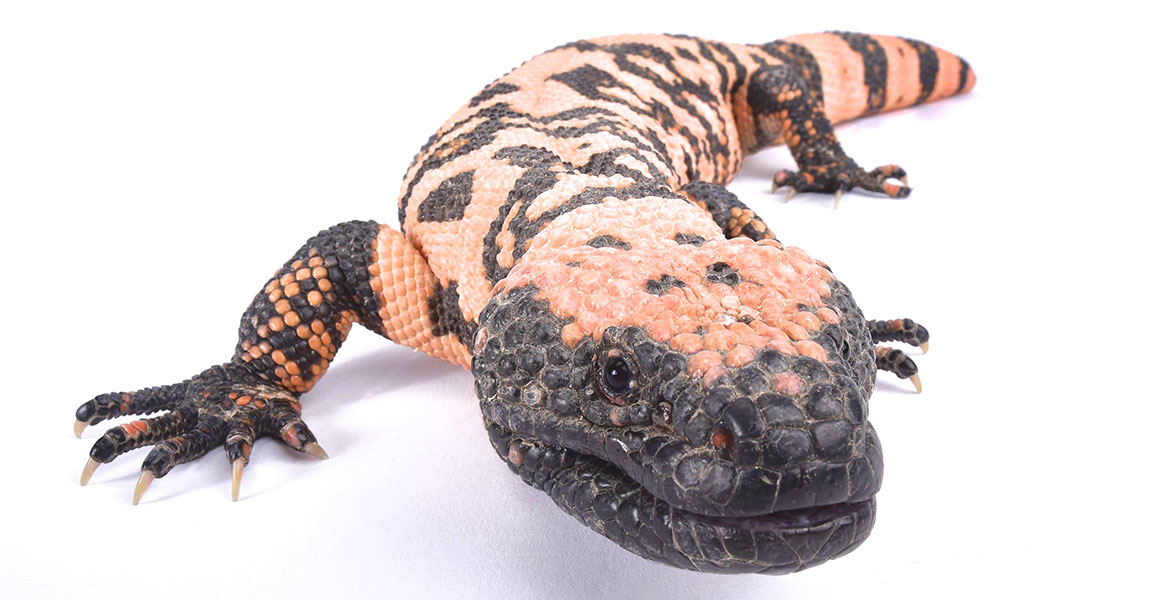
Image from here
Source (1,4,5)
The Gila monster is also known as Heloderma suspectum. Gila monsters are large, nocturnal reptiles most commonly found in Mexico, Guatemala, and the southwest United States. They typically have dark brown or black markings on a yellow, orange, or salmon body. Gila monsters have venom glands located on each side of their lower jaw that carry the venom to the mucus membrane between the lower jaw and lip at the base of their grooved teeth. When a Gila monster bites a victim, it opens and closes its mouth repeatedly deeper in the flesh each time. This causes the venom to be drawn from the glands via capillary action. Envenomation requires sustained biting contact and the grinding motion.
The venom of Gila monsters is primarily made up of at least 39 macromolecular proteins containing fatty material, enzymes (diastase and lipase), phospholipase A, hyaluronidase, serotonin, protease, gilatoxin and kallikrein. Gila monster venom also contains sodium, potassium, calcium, magnesium, aluminum, zinc, copper, iron, and silicon. Their venom is as potent as the venom found in rattlesnakes, but it has low enzymatic activity, so it is less dangerous than originally believed.
Below is a video that summarizes characteristics of the Gila monster and envenomation.
Video from YouTube
Toxicokinetics and Biotransformation (2,5)
As described above, Gila monster venom is made up of a wide variety of proteins and enzymes, so there is not one specific toxicokinetic or biotransformation pathway. The phospholipase A and protease in Gila monster venom causes tissue breakdown and allows for an efficient distribution of venom throughout tissues in the body leading to its systemic effects. Researchers have discovered a unique component they named gilatoxin that has characteristics of a serine protease with kallikrein and thrombin-activating activity. Gilatoxin cleaves angiotensin I which leads to hypotensive effects.
Some biotransformation is thought to occur in some of the protein components of the venom. The complexity of the venom components is due to genetic isoforms and post-translational modifications such as proteolytic processing. It is thought that the peptide toxins are secreted as proforms and activated by proteolytic cleavage following secretion.
Mechanism of Action (2)
A specific mechanism of action is not defined, but each of the components in Gila monster venom are responsible for the characteristic effects following a Gila monster bite. The tissue breakdown effects of Gila monster venom is caused by phospholipase A and protease. It is believed the hyaluronidase and activated hydrolases lead to the development of edema. The hypotensive effects may be caused by the cleavage of angiotensin I by gilatoxin and decreased blood flow.
Target organs (1)
- Skin
- Heart
- Respiratory system
- Nervous system
Biomarkers (2)
There are no biomarkers available to identify Gila monster toxicity. Diagnosis is typically based on patient reporting that includes the nature and duration of the bite and time since envenomation.
Signs and symptoms of toxicity (2,3,4)
Image from here
Severity of symptoms depends on the depth, duration, and extent of the bite.
- Pain
- Edema
- Hypotension
- Tachycardia
- Nausea
- Vomiting
- Weakness
- Dizziness
- Anxiousness
- Diaphoresis (sweating)
Treatments (2,3)
No antivenin is available to counteract the effects of Gila monster venom. The only treatments available are supportive care measures based on specific symptom presentation. Wounds should be cleaned with a bactericide such as iodine and irrigated with normal saline. The wound should also be examined for teeth that may have remained after the bite. Other supportive care treatments may include analgesics for pain, antiemetics for nausea and vomiting, IV fluids for hypotension (and vasopressor if severe hypotension), and antibiotics for potential infection for the bite wound.
Patients should be monitored for at least 24 hours after the bite to watch for any additional delayed systemic toxicity.
Carcinogenicity
Gila monster venom has not been found to be carcinogenic.
Genetic susceptibility or heritable traits
There have been no reported genetic or heritable traits that affect the level of toxicity of Gila monster envenomation.
Historical or unique exposures (6)
A unique use of the Gila monster is in the treatment of type 2 diabetes. The synthetic drug exenatide is a 39-amino acid peptide isolated from the saliva of the Gila monster. Exenatide is in a class of drugs called incretin mimetics that mimics the effects of glucagon-like-peptide-1 (GLP-1), also known as incretin. This peptide hormone regulates glucose homeostasis following meals, enhances insulin secretion, slows gastric emptying, and reduces food intake. Treatment with exenatide results in lowered A1C levels and weight loss in these diabetic patients.
References
1. Bonnet MS. The Toxicology of Heloderma Suspects: The Gila Monster. British Homeopathic Journal. July 2000; 89: 198-204.
2. Strimple PD, Tomassoni AJ, Otten EJ, Bahner D. Report on envenomation by a Gila monster (Heloderma suspectum) with a discussion of venom apparatus, clinical findings, and treatment. Wilderness and Environmental Medicine. 1997; 8: 111-116.
3. Hooker KR, Caravati EM. Gila Monster Envenomation. Annals of Emergency Medicine. October 1994; 24(4): 731-735.
4. Watkins JB, III. Toxic Effects of Plants and Animals. In: Klaassen CD. eds. Casarett and Doull’s Toxicology: The Basic Science of Poisons, Eighth Edition. McGraw-Hill; Accessed July 25, 2020. https://accesspharmacy-mhmedical-com.proxy.lib.ohio-state.edu/content.aspx?bookid=958§ionid=53483751
5. Sanggaard KW, Dyrlund TF, Thomsen LR, et al. Characterization of the gila monster (Heloderma suspectum) venom proteome. Journal of Proteomics. January 2015; 117: 1-11.
6. Triplett C, Chiquette E. Exenatide: From the Gila Monster to the Pharmacy. Journal of the American Pharmacists Association. January/February 2006; 46(1): 44-55.